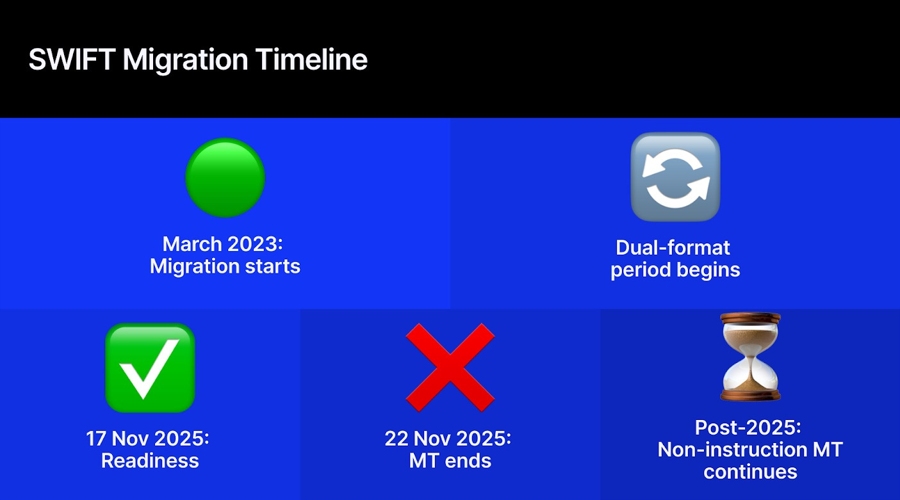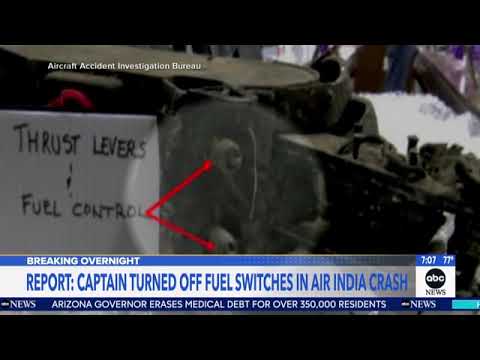SWIFT is preparing for a major structural change in the
global payments system. The shift will end an older messaging framework and
introduce a data-driven approach to cross-border transactions.
Discover
how neo-banks become wealthtech in London at the fmls25
On 22 November 2025, SWIFT will complete its migration to
the ISO 20022 CBPR+ standard. The network connects more than 11,000 banks and
financial institutions across over 200 countries. The cutover will retire the
long-standing MT format for core payment instructions and replace it with a
unified framework built for richer, more consistent data.
SWIFT has also tested
connections with blockchain networks to explore cross-border transfers, CBDC
payments, and asset tokenization.
The transition has been underway since March 2023, when
SWIFT entered a coexistence period allowing both MT and MX formats. This period
ends on 22 November 2025. After that date,
financial-institution-to-financial-institution payment instructions must be
sent exclusively in ISO 20022.
Institutions continuing to use MT for core cross-border
payments risk delays, rejections, or forced conversions through contingency
services, which add costs and reduce transparency.
Connected Blockchains
SWIFT has tested connections between its ISO 20022 framework
and several
blockchain networks. Ripple has been used for interbank settlements and
CBDC payments. Stellar has supported cross-border transfers and stablecoins.
Algorand has been trialed for asset tokenization and digital bonds. Hedera has
been applied to corporate and government registries. Quant functions as a
gateway between banks and blockchains.
Industry observers expect that by January 2026, further
integration of CBDCs and tokenized assets
will take place, potentially supporting new models of digital monetary
transactions and cross-network interoperability.
Operational Advantages
Murthy Maddali, Managing Director at Techwave
Murthy Maddali, Managing Director at Techwave, highlights
that “ISO 20022 facilitates improved compliance with regulations like AML
and GDPR through enriched data.”
He adds that “automation reduces costs and errors while
accelerating processing speed,” and notes that its “API-driven
integration offers scalability, enhanced customer transparency, and robust
encryption-based data security.”
The standard is also designed to reduce fraud and human
error, improve traceability, and support cross-border trade, while enabling all
participants to communicate using a consistent messaging framework for
cross-border payments under CBPR+.
Final Migration Timeline
SWIFT has divided the last phase into three stages. On 17
November 2025, ISO 20022 enters full operational readiness. Between 17 and 24
November, banks and market infrastructures across Europe, Asia, and the United
States will conduct synchronized migration steps. The full switch on 22
November marks the point when MT payment instructions become unsupported for
live traffic.
Citibank is leading the ISO 20022 migration for SWIFT. Every bank will follow, this is the new standard for global payments.
ISO 20022 fixes messaging, not settlement. That’s the gap. #XRP is the bridge that makes real-time value transfer possible.https://t.co/4RHx9A7CtV pic.twitter.com/H0HuerdH7Y
— Black Swan Capitalist (@VersanAljarrah) September 10, 2025
Scope of the Change
The cutover applies mainly to payment instruction messages,
which are central to correspondent banking operations. Some other MT
categories, such as reporting and investigations, will remain in place under a
phased roadmap beyond 2025. However, the main effect is significant: core
cross-border payments will move to a single modern standard for the first time.
Purpose of Adopting ISO 20022
ISO
20022 provides richer and more structured data, improving automation,
reconciliation, compliance screening, and processing efficiency. More detailed
data reduces manual work and lowers the likelihood of errors. Regulators
consider the increased granularity useful for transparency and financial-crime
monitoring.
Connection to Market Innovation
The standard aligns with developments in tokenization,
programmable payments, and central bank digital currency initiatives. SWIFT has
conducted trials linking its interface to distributed-ledger networks to test
how tokenized assets or CBDCs
could move across different systems.
These trials are exploratory, not full
production deployments, but they indicate how the messaging shift may support
future interoperability.
Industry Expectations After the Cutover
Observers expect that attention will shift in early 2026
toward experiments with tokenized securities, on-chain settlement models, and
early CBDC interoperability frameworks. ISO 20022’s structured data model is
viewed as a prerequisite, allowing traditional institutions to interact with
digital-asset systems through standard fields and consistent formats.
Operational Readiness and Risks
Banks still preparing face increasing urgency. SWIFT has
warned that missing the November deadline could result in operational
disruptions, higher processing costs, and reduced efficiency. Central banks and
industry groups in several regions have launched readiness programs to support
testing and training.
Industry participants believe the cutover will create a more
standardized environment for core cross-border payments. They expect
improvements in data quality, operational efficiency, and the ability to
accommodate emerging payment technologies.
The full implications of the
transition will become clearer once ISO 20022 is fully implemented and market
participants adjust their systems and processes.
SWIFT is preparing for a major structural change in the
global payments system. The shift will end an older messaging framework and
introduce a data-driven approach to cross-border transactions.
Discover
how neo-banks become wealthtech in London at the fmls25
On 22 November 2025, SWIFT will complete its migration to
the ISO 20022 CBPR+ standard. The network connects more than 11,000 banks and
financial institutions across over 200 countries. The cutover will retire the
long-standing MT format for core payment instructions and replace it with a
unified framework built for richer, more consistent data.
SWIFT has also tested
connections with blockchain networks to explore cross-border transfers, CBDC
payments, and asset tokenization.
The transition has been underway since March 2023, when
SWIFT entered a coexistence period allowing both MT and MX formats. This period
ends on 22 November 2025. After that date,
financial-institution-to-financial-institution payment instructions must be
sent exclusively in ISO 20022.
Institutions continuing to use MT for core cross-border
payments risk delays, rejections, or forced conversions through contingency
services, which add costs and reduce transparency.
Connected Blockchains
SWIFT has tested connections between its ISO 20022 framework
and several
blockchain networks. Ripple has been used for interbank settlements and
CBDC payments. Stellar has supported cross-border transfers and stablecoins.
Algorand has been trialed for asset tokenization and digital bonds. Hedera has
been applied to corporate and government registries. Quant functions as a
gateway between banks and blockchains.
Industry observers expect that by January 2026, further
integration of CBDCs and tokenized assets
will take place, potentially supporting new models of digital monetary
transactions and cross-network interoperability.
Operational Advantages
Murthy Maddali, Managing Director at Techwave
Murthy Maddali, Managing Director at Techwave, highlights
that “ISO 20022 facilitates improved compliance with regulations like AML
and GDPR through enriched data.”
He adds that “automation reduces costs and errors while
accelerating processing speed,” and notes that its “API-driven
integration offers scalability, enhanced customer transparency, and robust
encryption-based data security.”
The standard is also designed to reduce fraud and human
error, improve traceability, and support cross-border trade, while enabling all
participants to communicate using a consistent messaging framework for
cross-border payments under CBPR+.
Final Migration Timeline
SWIFT has divided the last phase into three stages. On 17
November 2025, ISO 20022 enters full operational readiness. Between 17 and 24
November, banks and market infrastructures across Europe, Asia, and the United
States will conduct synchronized migration steps. The full switch on 22
November marks the point when MT payment instructions become unsupported for
live traffic.
Citibank is leading the ISO 20022 migration for SWIFT. Every bank will follow, this is the new standard for global payments.
ISO 20022 fixes messaging, not settlement. That’s the gap. #XRP is the bridge that makes real-time value transfer possible.https://t.co/4RHx9A7CtV pic.twitter.com/H0HuerdH7Y
— Black Swan Capitalist (@VersanAljarrah) September 10, 2025
Scope of the Change
The cutover applies mainly to payment instruction messages,
which are central to correspondent banking operations. Some other MT
categories, such as reporting and investigations, will remain in place under a
phased roadmap beyond 2025. However, the main effect is significant: core
cross-border payments will move to a single modern standard for the first time.
Purpose of Adopting ISO 20022
ISO
20022 provides richer and more structured data, improving automation,
reconciliation, compliance screening, and processing efficiency. More detailed
data reduces manual work and lowers the likelihood of errors. Regulators
consider the increased granularity useful for transparency and financial-crime
monitoring.
Connection to Market Innovation
The standard aligns with developments in tokenization,
programmable payments, and central bank digital currency initiatives. SWIFT has
conducted trials linking its interface to distributed-ledger networks to test
how tokenized assets or CBDCs
could move across different systems.
These trials are exploratory, not full
production deployments, but they indicate how the messaging shift may support
future interoperability.
Industry Expectations After the Cutover
Observers expect that attention will shift in early 2026
toward experiments with tokenized securities, on-chain settlement models, and
early CBDC interoperability frameworks. ISO 20022’s structured data model is
viewed as a prerequisite, allowing traditional institutions to interact with
digital-asset systems through standard fields and consistent formats.
Operational Readiness and Risks
Banks still preparing face increasing urgency. SWIFT has
warned that missing the November deadline could result in operational
disruptions, higher processing costs, and reduced efficiency. Central banks and
industry groups in several regions have launched readiness programs to support
testing and training.
Industry participants believe the cutover will create a more
standardized environment for core cross-border payments. They expect
improvements in data quality, operational efficiency, and the ability to
accommodate emerging payment technologies.
The full implications of the
transition will become clearer once ISO 20022 is fully implemented and market
participants adjust their systems and processes.






